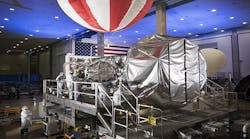The third satellite in the Mobile User Objective System (MUOS) has been approved for operation by the United States Navy after a series of in-orbit tests were completed on June 1. Manufactured by Lockheed Martin and launched on January 20, the MUOS-3 satellite is currently being relocated to its operational orbit.
The satellite is the latest addition to a network of orbiting satellites and ground stations expected to provide near global coverage by the end of the year. The MUOS network is a narrowband tactical satellite communications system designed to keep soldiers on the ground connected. MUOS terminals carried by soldiers will support simultaneous voice, video and mission data on a high-speed Internet protocol system.
“This latest satellite will expand the MUOS network’s coverage over more than three-quarters of the globe, including significantly more coverage north and south than the current legacy voice-only system,” Iris Bombelyn, Lockheed Martin’s vice president for narrowband communications, said in a statement.
Providing capabilities similar to today’s smartphones, the MUOS system is being installed to replace the current Ultra-High Frequency Follow-On (UFO) communications system. The MUOS satellites are equipped with a Wideband Code Division Multiple Access (WCDMA) payload that provides 16 times more transmission throughput than the current Ultra High Frequency (UHF) satellite system.
Each MUOS satellite also includes a legacy UHF payload that is fully compatible with the current UHF Follow-on system and legacy terminals. This dual-payload design, coupled with support on the ultra-high frequency band, ensures a smooth transition from the outdated UFO system.
Lockheed Martin is under contract to deliver five satellites and the four associated ground stations for the MUOS network. The last ground station was handed over to the Navy in February and the fourth satellite, MUOS-4, is expected to launch later this year. The MUOS-1 was launched in 2012, and the MUOS-2 was launched a year later. Both are already fully operational.
